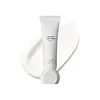What's inside
What's inside
 Key Ingredients
Key Ingredients

 Benefits
Benefits

 Concerns
Concerns

 Ingredients Side-by-side
Ingredients Side-by-side

Water
Skin ConditioningIsododecane
EmollientC13-15 Alkane
SolventNylon-12
Alcohol Denat.
AntimicrobialSilica
AbrasiveDimethicone
EmollientTrimethylsiloxysilicate
EmollientMica
Cosmetic ColorantPentylene Glycol
Skin ConditioningButylene Glycol
HumectantGlycerin
HumectantIsononyl Isononanoate
EmollientNiacinamide
SmoothingCetyl PEG/PPG-10/1 Dimethicone
EmulsifyingTitanium Dioxide
Cosmetic ColorantPolyglyceryl-4 Isostearate
EmulsifyingDimethicone/Vinyl Dimethicone Crosspolymer
Skin ConditioningSalix Nigra Bark Extract
Skin ProtectingCentella Asiatica Leaf Extract
Skin ConditioningCentella Asiatica Extract
CleansingMagnesium Sulfate
Disteardimonium Hectorite
StabilisingPEG-10 Dimethicone
Skin ConditioningTriethoxycaprylylsilane
Vinyl Dimethicone/Methicone Silsesquioxane Crosspolymer
Aluminum Hydroxide
EmollientAdenosine
Skin ConditioningTrisodium Ethylenediamine Disuccinate
Ectoin
Skin ConditioningMadecassoside
AntioxidantAsiaticoside
AntioxidantMadecassic Acid
Skin ConditioningAsiatic Acid
Skin ConditioningWater, Isododecane, C13-15 Alkane, Nylon-12, Alcohol Denat., Silica, Dimethicone, Trimethylsiloxysilicate, Mica, Pentylene Glycol, Butylene Glycol, Glycerin, Isononyl Isononanoate, Niacinamide, Cetyl PEG/PPG-10/1 Dimethicone, Titanium Dioxide, Polyglyceryl-4 Isostearate, Dimethicone/Vinyl Dimethicone Crosspolymer, Salix Nigra Bark Extract, Centella Asiatica Leaf Extract, Centella Asiatica Extract, Magnesium Sulfate, Disteardimonium Hectorite, PEG-10 Dimethicone, Triethoxycaprylylsilane, Vinyl Dimethicone/Methicone Silsesquioxane Crosspolymer, Aluminum Hydroxide, Adenosine, Trisodium Ethylenediamine Disuccinate, Ectoin, Madecassoside, Asiaticoside, Madecassic Acid, Asiatic Acid
Dicaprylyl Carbonate
EmollientDimethicone
EmollientSilica
AbrasiveMica
Cosmetic ColorantStearyl Dimethicone
EmollientPolymethylsilsesquioxane
Octyldodecanol
EmollientKaolin
AbrasiveSynthetic Wax
AbrasiveVinyl Dimethicone/Methicone Silsesquioxane Crosspolymer
Polyglyceryl-2 Triisostearate
EmulsifyingCetyl PEG/PPG-10/1 Dimethicone
EmulsifyingSorbitan Isostearate
EmulsifyingPhenoxyethanol
PreservativeTriethoxycaprylylsilane
Polyhydroxystearic Acid
EmulsifyingTocopheryl Acetate
AntioxidantAluminum Hydroxide
EmollientEthylhexylglycerin
Skin ConditioningTocopherol
AntioxidantAminopropyl Triethoxysilane
CI 77891
Cosmetic ColorantCI 77491
Cosmetic ColorantCI 77492
Cosmetic ColorantCI 77499
Cosmetic ColorantCI 17200
Cosmetic ColorantCI 15850
Cosmetic ColorantDicaprylyl Carbonate, Dimethicone, Silica, Mica, Stearyl Dimethicone, Polymethylsilsesquioxane, Octyldodecanol, Kaolin, Synthetic Wax, Vinyl Dimethicone/Methicone Silsesquioxane Crosspolymer, Polyglyceryl-2 Triisostearate, Cetyl PEG/PPG-10/1 Dimethicone, Sorbitan Isostearate, Phenoxyethanol, Triethoxycaprylylsilane, Polyhydroxystearic Acid, Tocopheryl Acetate, Aluminum Hydroxide, Ethylhexylglycerin, Tocopherol, Aminopropyl Triethoxysilane, CI 77891, CI 77491, CI 77492, CI 77499, CI 17200, CI 15850
Ingredients Explained
These ingredients are found in both products.
Ingredients higher up in an ingredient list are typically present in a larger amount.
Aluminum Hydroxide is a form of aluminum. It can be naturally found in nature as the mineral gibbsite. In cosmetics, Aluminum Hydroxide is used as a colorant, pH adjuster, and absorbent.
As a colorant, Aluminum Hydroxide may add opacity, or reduce the transparency. Aluminum hydroxide is contains both basic and acidic properties.
According to manufacturers, this ingredient is an emollient and humectant. This means it helps hydrate the skin.
In medicine, this ingredient is used to help relieve heartburn and help heal ulcers.
There is currently no credible scientific evidence linking aluminum hydroxide in cosmetics to increased cancer risk.
Major health organizations allow the use of aluminum hydroxide in personal care products and have not flagged it as a carcinogenic risk at typical usage levels.
Learn more about Aluminum HydroxideThis ingredient is a high molecular weight silicone. It has emulsifying and skin conditioning properties.
Dimethicone is a type of synthetic silicone created from natural materials such as quartz.
What it does:
Dimethicone comes in different viscosities:
Depending on the viscosity, dimethicone has different properties.
Ingredients lists don't always show which type is used, so we recommend reaching out to the brand if you have questions about the viscosity.
This ingredient is unlikely to cause irritation because it does not get absorbed into skin. However, people with silicone allergies should be careful about using this ingredient.
Note: Dimethicone may contribute to pilling. This is because it is not oil or water soluble, so pilling may occur when layered with products. When mixed with heavy oils in a formula, the outcome is also quite greasy.
Learn more about DimethiconeMica is a naturally occurring mineral used to add shimmer and color in cosmetics. It can also help improve the texture of a product or give it an opaque, white/silver color.
Serecite is the name for very fine but ragged grains of mica.
This ingredient is often coated with metal oxides like titanium dioxide. Trace amounts of heavy metals may be found in mica, but these metals are not harmful in our personal products.
Mica has been used since prehistoric times throughout the world. Ancient Egyptian, Indian, Greek, Roman, Aztec, and Chinese civilizations have used mica.
Learn more about MicaSilica, also known as silicon dioxide, is a naturally occurring mineral. It is used as a fine, spherical, and porous powder in cosmetics.
Though it has exfoliant properties, the function of silica varies depending on the product.
The unique structure of silica enhances the spreadability and adds smoothness, making it a great texture enhancer.
It is also used as an active carrier, emulsifier, and mattifier due to its ability to absorb excess oil.
In some products, tiny microneedles called spicules are made from silica or hydrolyzed sponge. When you rub them in, they lightly polish away dead skin layers and enhance the penetration of active ingredients.
Learn more about SilicaTriethoxycaprylylsilane is a silicone used to bind and stabilize ingredients.
As an emulsifier, it helps prevent ingredients from separating. This can help elongate the shelf life of products.
Triethoxycaprylylsilane is often used to coat mineral sunscreens ingredients to help give a better feel. It also helps reduce oxidative stress in sunscreens.
Learn more about TriethoxycaprylylsilaneThis ingredient is used in makeup and skincare to thicken formulas, reduce shine, and give skin a silky-smooth feel.
It’s a white silicone powder that sits in fine lines and pores to blur their appearance though its effectiveness depends on the particle size.
You'll typically find this ingredient in amounts between 0.1-20%.
Learn more about Vinyl Dimethicone/Methicone Silsesquioxane Crosspolymer